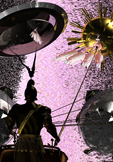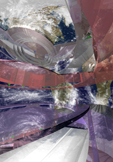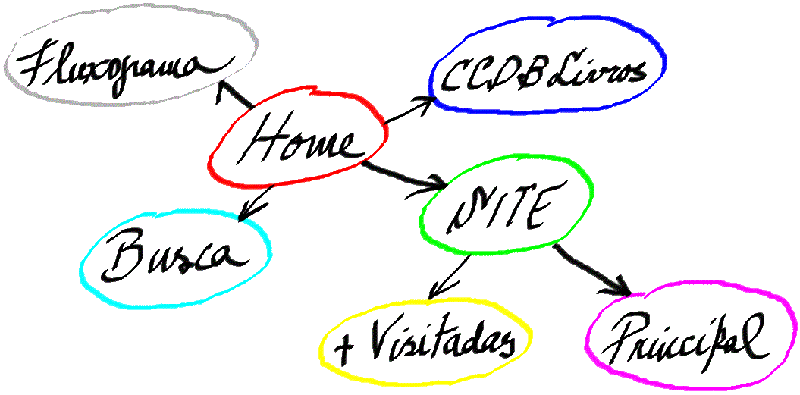




When Géa is filmed
which translates to Portuguese as:
Download and see the superb CCDB animation!
Ky Hi-Tech Dança Proust Lembrado
in the best video quality, CCDB and Ky, the greatest ballet dancer of the Universe!
See also the previous version of the ballet: Ky dança Proust Lembrado
CCDB plays on-stage during the Brazilian (MPB) Festival with the other Mutantes and Gilberto Gil - the “mov”, produced by BOSSANOVAFILMS during 2012, shows the intense work of Cláudio César Dias Baptista - CCDB inside the musical group Os Mutantes which he created with Raphael Vilardi, including work on-stage, playing with Arnaldo Baptista, Sérgio Dias, Rita Lee and Gilberto Gil at the Brazilian Pop Music Festival (via Record Television) where they presented the song “2001”. As CCDB is seen via Television and Cinema, the opus “Géa” will be seen also. |
Géa will inevitably (sic) be filmed. This page suggests possible sequences of films and episodes and explains the reasons for that suggestion. Reading the preceding paragraph, it comes to mind the complex sequence of Star Wars films. However, that of starting beyond of the start (...) is not a novelty: three thousand years ago, Homer initiated Iliada after the beginning of the War of Troy and finished the opus before the Horse of Troy episode. The ideal for the filming of Géa should be the several films, that the opus merits, obey the same sequence of its twelve text books. Realizing all the films in a single breath will perhaps surpass the possibilities of the large cinematographic companies, even those that today invest far more than one hundred million dollars in a single full-length film. That may not be the more commercial way to launch the opus in cinema: excluding the exceptions, cinema purposes in first place entertainment, its major source of profit. Géa is also a marvelous entertainment, nevertheless it is much more; because of that "much more", the sequence of the books follows other priorities, that will be discovered during the reading. One has, however, to alert: it is preferable to accomplish the whole cinematographic opus, all the films in a single outpour, to maintain the same artists and with the same appearance (where the text defines that thing) along the sequence, which facilitates also the contract of those artists and reduces the risk of precluding accidents. Mentioning artists, I affirm: without those whose appearance captivates the public, no film will triumph. Where the opus says: beautiful "kena" or woman, it MUST be so; idem, where it says terrible, frightful, stunning, lethal, and so forth. It isn't enough the beauty: there must be personality and all that captivates the attention from the beginning to the end of the film in EACH personage, so anybody who sees it may leave the theater, saying: - Just because of Ky* (or Gia, or Clausar, and so on), the film was excellent! She (or he) convinces! Oh, if I knew somebody like her (or him)... Therefore, here is my suggestion for one, the more commercial, of the many ways to create and to put on the market films based on Géa: First film: starting in Livro Sexto from the chapter Ansata (read this page, please, to see details about that chapter and the chapter Nu, full of action - you may download both chapters there, in PDF), going ahead in Livro Sétimo, then in Livro Oitavo and finishing in Livro Nono. That because the pungent story of Clausar in the search of the ballet dancer Ansata starts and goes on, initiatory, through the stars of the Constelação da Telária in Livro Sexto, ending with the discovery that Ansata is Ky, his own daughter (then lover), in Livro Oitavo, and concluding that tremendous adventure with the discovery of the "beldo" (love) of his "gédia" (life) in Livro Nono, where the Guerra Galáctica (Galactic War) gives a conclusion of extreme action to the already lively whole of those books. The first film should be, therefore, of the most intense action, from the beginning until the end. And there would be great scenes of music and dance, without omission of love affair, the deepest "saudade", the erotism (of a sublime courage) and the tragedy, in atmospheres of mystical and vast science fiction. Addendum by CCDB from February 04, 2009: That first film, mentioned above, may be subdivided in two, because the themes are much varied and admit it, but mainly because, with the subdivision, in place of maintaining the character Clausar as master line, or central protagonist, as it would be if we made only one film, we would had valorized two characters: in the first film (of the subdivision), that valorized character would be Ky - and her prohibited romantic love affair with her father Clausar; in the second film (of the subdivision) the valorized character would be Gia - and her romantic love affair with Clausar, this one in accordance with the social values and politically correct. Not only the romantic love affairs would be valorized with the subdivision; but, also, all the action and the vicissitudes of each part (each film of the subdivision), giving a more linear and firm sense to each one of the two films of the subdivision and greater equilibrium between the protagonists. The first film of the subdivision would start in the Livro Sexto (Book Six), beginning with the chapter "Ansata", would continue in the entire Livro Sétimo (Book Seven) and would end at the final of the chapter "Ky", in the Livro Oitavo (Book Eight). The second film of the subdivision would begin in Livro Oitavo (Book Eight), chapter "I am Ky, and would end in Livro Nono (Book Nine), with the end of the Galactic War. Second film: starting in Livro Onze, finishing in Livro Doze and presenting the fight of the heroes of the first film and many others against the Desrelacionador, terminates the saga of Clausar, of the Kys Únicos, of the own Géo (God); but, not, of the sempiternal Géa (the Life Force, the Essence of the essences and the feminine part of God - not, here, the homonym planet). Although the description of the second film appears smaller in this paragraph, in nothing it would be indebted to the first film (much on the contrary! one who reads Géa will confirm) and in no way it would be one of those notorious "film number II of a series" where the argument decays and what is shown is the profit wish of a decadent business. The second film should be, then, also of intense action and of big and conclusive dénouements to the whole opus. The first and the second films could blend in a single one, because there is always continuity in the whole opus, but many grand scenes would be discarded, or the film would be too long. But I think it will be more profitable to maintain separed the first and the second films, or even to transform them in three, with the division of the first one in two - as it is said in my addendum of February 04, 2009. Third film: it should start in Livro Segundo, going ahead in Livro Terceiro and finishing in Livro Quarto, telling the great adventure of the adolescent Rá, son and father of Clausar, that knew the Kys (Souls, Incorporeal Entities) and saved the magnificent planet Penta Ro Bolinei, even being this the greatest enemy of the worlds of Kycla (the Galaxy). In this film it would flaunt Tóxia, the Telária (spider of the planet Géa) of the Lethal Poison and all a new way to see the world of the small beings, and also the one of the disembodieds, with no lack of the indispensable presence of the bio-computer and of the flying saucer named Laranja, the most powerful space ship of the Universe, which detailed technical description permits the creation of prototypes and which flights will transport the Spectator to places "nunca de antes navegados" (never navigated before) where not one Camões has been before - and much less the Enterprise - verbi gratia, to the core of a sun! The third film would be, then, of intense action yet, and should include optimal characters to motivate the youth. Fourth film: it would start in Livro Primeiro (not including the books Segundo, Terceiro e Quarto), going ahead in Livro Quinto and finishing just before the chapter Ansata, in Livro Sexto, including or not the Livro Décimo. That because the Livro Primeiro contains the "many beginnings" of the opus Géa (where the characters are deeply presented, so that the Reader can love or hate them, and so, during the reading of the remainder of the opus), and the Livro Quinto shows a return of Clausar to the past, reviving the episodes of his life. In these books culminates the mystical and lysergic adventures and appears the tragedy of Ardo, brother of Clausar. The fourth film would be, then, of recognition of the characters and of the motives that carried them to act as they did in the preceding films. That fits very well in this point of the film series, because people, acquainted with the characters, would like to know more about them and would see them more "humanized", even those aliens, that of "humans" at first sight contains nothing. Addendum by CCDB from February 11, 2009: The fourth film will serve as an excellent base for television series, because of it's large variety of protagonists, situations and scenaries, which will facilitate the creation of new adventures and the interaction between such protagonists, in multiple ambients and with multiplied stories, avoiding boredom and repetition so usual in television series. Fifth film: the Livro Décimo is a self-sufficient adventure, where Terrar and the supravirtual reality entities Iulia and Cleona live sexual initiations (sometimes extremely comical) while Arqueu, the ageratum man with forty thousand years old and father of the alchemy, records a disc of the musical group Atlantes, formed by Clausar, Ardo, Sérias and Ree. This book would be the basement for episodes of the fourth film or should be a fifth cinematographic opus. The fifth film would be, then, an extra story, with new and exciting characters, to add to the first four, but not least, in more pleasant surroundings, with comic-erotic scenes and also of professional audio recording, allowing the inclusion of music/songs, to be divulged with the film, and also of stage spectacles. Sixth film: written all at one stretch, replete of surprises in each page and an unutterable richness of scenes, the book called )que( is a self-suficient opus: one may read it before Géa. Despite of that, with its entanglement, strong and fertile as the one of Géa, the book )que( contains the roots of the themes and of the characters of Géa and is not only the preamble but also the continuation of the supreme opus: )que( tells stories happened before and after the period narrated in Géa, magnifying its scope and clarifying hidden questions and motivations. The sixth film would be, then, another extra story, with the same and also new and magnetizing characters, to add to the first five, closing the whole with a diamond key, till I write another opus that measures up to it. As a matter of fact (note of January 31, 2007) I already wrote the children and teenager series named Geínha, which will be the source of many films and television series. And soon will came to the light of the Sun other books from my authorship. It is very important to understand that the forementioned sequencies won't be preferable in the text books. They are just those that would lend itself, perhaps, to the cinematographic industry. I would never write Géa in another sequence that not the original, to be read in books: it is still the best. Despite what I affirm in the paragraph just above, this page stays as a suggestion for a different order in reading the Géa books and the book named )que(, ONLY to one who prefers the "cinematographic" sequence (forementioned) and the simple entertainment. - CCDB June16, 2005 * Pronunciation: "Key". Summary of the "cinematographic"sequence: First Film: starts in the chapter Ansata, book Sexto, goes ahead in the books Sétimo, Oitavo and finishes at the end of the book Nono. Or, in place of the First Film, the two films of the subdivision suggested in the text above, beginning the first film (of the subdivision) in the chapter "Ansata", Livro Sexto (Book Six), and finishing in the chapter "Ky", Livro Oitavo (Book Eight); and beginning the second film (of the subdivision) in the beginning of the chapter "I am Ky", Livro Oitavo (Book Eight) and finishing in Livro Nono (Book Nine), with the end of the Galactic War. - CCDB February 4, 2009. Second Film: books Onze and Doze. Third Film: books Segundo, Terceiro and Quarto. Fourth Film: books Primeiro, Quinto and finishes before the chapter Ansata in book Sexto. Fifth Film: book Décimo. Sixth Film: book )que(. Summary of the summary: 6 to 9 - or 6 to 8 + 8 + 9, in two films 11 and 12 2 to 4 1, 5 and 6 10 )que(
|
Other requirements to the films of my books: Photography The photography must be Photography with a capital K... That is: framing, contrast, transparency, direct and difuse lights, focus - that must be absolute, on the brink of, in the artist face, remember the images of the insects in the film Microcosmo, if not those of an electronic microscope: nothing of to hide supposed imperfections in an actress face and "embellish" it with blur! And as blur is a special effect, since now the special effects are limited to the indispensable and to never flaunt: "- I am a great special effect!", in the photography or in the CG (Computer Graphics or Computer Generated Image - CGI). The perfect photography arises during all the film; not, at a peak that distracts the Spectator to the act of photographing. The ideal will be the progressive discovery of the photography's presence during the film, that will culminate in the conscience of that presence during a mute scene (therefore, in which the entanglement cannot be disturbed by that conscience), where the landscape (that was, verbi gratia, the strong point of the westerns) or the face of an actor or actress with the transparent crystalline lenses refracts the light, and other iridescent similar beauties. I know that time makes obsolete the technology, but I dare to oppose two films, both very good in photography: when I saw the first (by television), it was the best: Armagedon. When I saw it again via DVD player and my insuperable CCDB Audio System (the sound helps the image with synesthesia), Armagedon lost from far to the photography with a capital K of the film Hulk. In Hulk it exonerated onself the merchandising of that yellow album (...): it was exactly the point, perhaps intentional, to remember the capital K behind the photography; and, not, simply a veiled advertisement of the company that does not need subterfuges. So much it doesn't need, that I am mentioning it not so dissimulately, altough I have not any marketing relationship with it and didn't even looked for its name in the credit lines of the Hulk DVD - if it was another company that supplied the technology, I'll be ready to substitute the K for another letter; an F? The lenses (even placed before digital circuits), the photographic films (or those circuits); but preferablely the yet inimitable films with their distinctive acetate luster (nothing of tricks here...); are still light years ahead the computer graphic images. My comment is useful, then, for today, 2005. Computer Graphics Computer graphics must be used in the films of my books - but ONLY where indispensable. Then it will be the one that obeys the rules of the title "Photography", above, and never flaunt: "- I am a great special effect!". That doesn't mean we must decrease its quality nor substitute it, when it is the best option; much on the contrary! my books demands more than the maximum possible for today's technology. Therefore, oblige to a large investment of money, including in computer graphics, with all its "global lighting", "causting", "raytracing", "materials" and so on. Artists The actors must be new; that is: debutants - at least virgins of world-wide divulged works, that stigmatized them. Verbi gratia: Leonard Nimoy versus mr. Spock. Nothing of barnstormers (the tallented Nimoy is not one...), or even great stars marked by other films, that would associate improperly them with the characters of my literary opus. Where I wrote "girl or kena (woman of the planet Géa) of sixteen years old or sixteen espectros (years of the planet Géa)", it cannot be an actress of twenty five, made-up to resemble sixteen... The Magna Vestal Intáctia, in her majestic blue nudity, would be splendidly rendered by the best brazilian actress of today, which facial expressiveness is worth as much as all the other stars together and multiplied; however, Intáctia is too young for her. The aged people must be rendered by aged artists; and, never! the same that appeared in "my" films when young, made-up to simulate old people - forgive me the brilliant cosmetician who almost attained perfection in the aging of the actor that rendered Salieri in the film Amadeus, because "almost" doesn't works for the films of my books. Translated by CCDB - June 16, 2005 Links to related pages (in Portuguese): Qual coisa é Géa? (What is Géa) Questionário sobre Géa. (Questions about Géa) Mais sobre filmes (More about films) |

Why do I utilize Google's services (Answer in Portuguese only)?